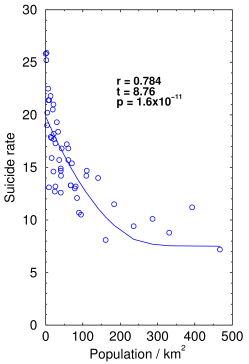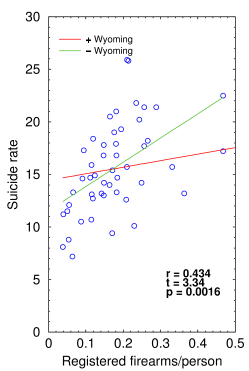 n the United States, men commit suicide at 3.5 times the rate of women. In the UK,
suicide is the biggest killer of men between 20 and 49. The rates are increasing
dramatically.
n the United States, men commit suicide at 3.5 times the rate of women. In the UK,
suicide is the biggest killer of men between 20 and 49. The rates are increasing
dramatically.
Ask why and you'll get stock answers: mental illness (especially borderline personality disorder), depression, traumatic experience, hopelessness, bullying, substance abuse, problems with relationships, and isolation or loneliness. These answers are all true, but they are also too general to be useful.
Suicide rates are inversely correlated with population density; among US states, high density states like New Jersey, New York, and Massachusetts have the lowest rates and Alaska, Wyoming, and Montana have the highest. This is not just due to the higher availability of firearms; globally, suicide rates are highest in Japan, where firearm availability is limited. In the US, suicide correlates with gun registrations, but less robustly than population density.

Suicide rate vs population density in 50 US states (2013, data from CDC). At densities above 200/km2 the rate remains constant at around 9.
I have had occasion to wonder about the reasons for suicide several times during my lifetime. My father committed suicide when I was nine. In grad school one of our most admired biochemistry professors committed suicide. These men seemed to have everything: a successful career, high social status, and good friends.
In general there seem to be three fundamental reasons behind most suicides: first, the person's defense mechanisms have failed; second, the person lacks supportive social contact; and third, they feel trapped in a hopeless situation.
Research shows that a person committing suicide typically believes the world would be better off without him. They are mistaken. The suffering of their children in such cases is almost unimaginable. In the first case, the father I idolized left us in the hands of a person who was destructive and resentful. Each of his children eventually fled to the opposite corner of the country, and the family effectively ceased to exist.
In the second case, the professor's students respected and admired him. He conducted valuable scientific research on blood coagulation and was in a position to increase the world's understanding and health. It is inconceivable that the world is better off without him. Yet he used his knowledge to calculate a lethal dose of potassium cyanide for himself.

Suicide rate vs registered firearms. Only 49 states are shown; Wyoming is way off the right of the graph (2.29 firearms/person, suicide rate = 25.2) and screws up the correlation. Without Wyoming, r increases to 0.51 and p-value is 0.00018.
Another theory is that some suicides are due to a maladaptive perfectionism, i.e. a perceived failure to live up to their own or others' expectations.[1] This idea presupposes an element of rigidity and inability to adapt to setbacks.
Suicide rates are higher among people experiencing severe pain. One study found that 47.2% of patients with chronic migraine with aura over 15 days/month had suicidal ideation compared with 2.8% in migraine-free controls.[2]
The person committing suicide knows what they're about to do will be painful, and that they might not die but be crippled for life. They might also realize that they will be killing a human being in an act of violence akin to murder, and that it will devastate the people around them. It is sometimes said that this takes a certain amount of courage, but it is probably more accurate to say that some factor has overcome the fear of death.
This suggests that a person contemplating suicide also suffers from cognitive impairment, whether from depression, drug abuse, or mental illness. Otherwise, they would know the ethical implications of what they're about to do. After all, death will happen automatically soon enough. If they want to die, all they need do is wait.
Perhaps emotional pain contributes to cognitive impairment, but there is also an element of self-hate. Men are told it is their own fault when the things they value most—their jobs, their culture, their friendships—are destroyed. When they internalize this as self-hate, they may deliberately punish themselves by subjecting themselves to even more pain.
One clue is that the rate of male suicide increases after retirement, as the man's sense of self-worth is sometimes diminished. The defense mechanisms he has built up can no longer be supported or are no longer applicable. They forget all the nasty things about work and remember only the pleasant things.
At some point, his defense strategies may fail, releasing what psychologists call thwarted belongingness. This can cause an unbearable sense of isolation. If the man cannot create a new defense mechanism, he may conclude that his life has no value. For some, calling a help line or even studying why this happens to others may convince them they are not alone.
This is, of course, not to ignore the fact that women suffer just as much, and their suicides are just as tragic.
Resilience to suicidality
The importance of building and maintaining human relationships throughout one's life and of living in a place where this is possible cannot be overemphasized. Much research [3][4] has focused on risk factors such as hopelessness, perfectionism, and feelings of entrapment and burdensomeness (see here for a discussion). But this approach has been spectacularly unsuccessful in predicting suicide,[5] so some psychologists now focus on resilience.
This is not just a change in viewpoint, where high self-esteem is treated a univariate polar opposite of increased risk due to low self-esteem. Resilience is a separate factor that mitigates suicide even when risk factors are present. The theory is still quite murky, but Johnson et al.[6] suggested that resilience involves a number of factors, such as:
- Attributional style: explaining events in positive terms
- Problem-solving ability: the ability to devise coping strategies to counter setbacks, and confidence in one's ability to solve problems
- Self-esteem, especially a sense of being esteemed by society
- Agency (seems to be a factor among men but not women)
- Social support from a partner or family
Johnson considered emotional intelligence, cognitive biases, and external focus as possible additional factors, while optimism is not a resilience factor but a risk factor when absent.
Women and feminist criticism
One of the strongest sources of resilience is social and sexual bonding, and this in turn may shed light on why male and female suicidality occurs with different frequency. It may be relevant that silent crying, which is a manifestation of frustrated attachment, is strongly disapproved of in men. Men are keenly aware that women are programmed to despise and reject men for showing signs of weakness and lower social status such as crying. This is not part of masculine ideology as the American Psychological Association (APA) claims, but a risk imposed on men by women and by society in general.
Feminists give us a different answer: masculine stoicism and alexithymia, the supposed inability to recognize or feel emotions. Some talk about “male fragility.” This term is not used in psychology and I could find no clear definition of it. In recent years the term seems to have fallen out of favor, and been appropriated by radical political groups to insult people. But feminists can provide a unique perspective. Constructive input from them is essential.
Social change is needed, but it can only succeed if ideology, politics, and conjecture are avoided. There is no scientific doubt that the presence of a father is essential to the well-being of children. There is also little scientific doubt that innate psychological differences exist between men and women. Those hoping to effect social change need to base their ideas on these empirical truths if they wish to succeed.
We are social beings, and neither men nor women can live in isolation. To liberate men from suicide, we must liberate both men and women. We should welcome the cooperation of anyone with constructive ideas to help us solve this problem. Lives depend on it.
1. Kiamanesh P, Dieserud G, Haavind H (2015). From a cracking façade to a total escape: maladaptive perfectionism and suicide. Death Stud. 39(1–5), 316–322. doi: 10.1080/07481187.2014.946625. PMID: 25590227
2. Lin YK, Liang CS, Lee JT, Lee MS, Chu HT, Tsai CL, Lin GY, Ho TH, Yang FC (2019). Association of Suicide Risk With Headache Frequency Among Migraine Patients With and Without Aura. Front Neurol. 10, 228. doi: 10.3389/fneur.2019.00228. PMID: 30941087 Link
3. Van Orden KA, Witte TK, Cukrowicz KC, Braithwaite SR, Selby EA, Joiner TE Jr (2010). The interpersonal theory of suicide. Psychol Rev. 117(2), 575–600. doi: 10.1037/a0018697. PMID: 20438238 Link See also the book Why people die by suicide (2005, Harvard Univ. Press) by TE Joiner
4. Hjelmeland H, Loa Knizek B (2019). The emperor's new clothes? A critical look at the interpersonal theory of suicide. Death Stud. Jan 29, 1–11. doi: 10.1080/07481187.2018.1527796. PMID: 30696383 Link
5. Belsher BE, Smolenski DJ, Pruitt LD, Bush NE, Beech EH, Workman DE, Morgan RL, Evatt DP, Tucker J, Skopp NA (2019). Prediction Models for Suicide Attempts and Deaths: A Systematic Review and Simulation. JAMA Psychiatry. Mar 13. doi: 10.1001/jamapsychiatry.2019.0174. Link PMID: 30865249
6. Johnson J, Wood AM, Gooding P, Taylor PJ, Tarrier N (2011). Resilience to suicidality: the buffering hypothesis. Clin Psychol Rev. 2011 31(4), 563–591. doi: 10.1016/j.cpr.2010.12.007. Link PMID: 21276646
apr 06 2019, 3:26 am. major revision apr 06 2019, 2:29 pm. last edited apr 07 2019 5:08 am
